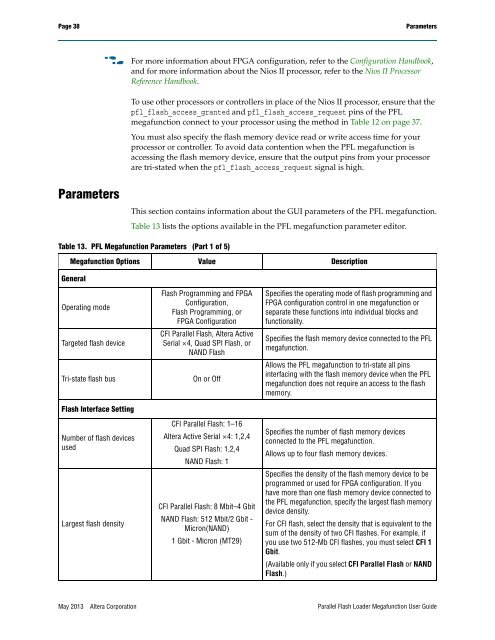Parallel Flash Loader Megafunction User Guide (PDF) - Altera
Parallel Flash Loader Megafunction User Guide (PDF) - Altera
Parallel Flash Loader Megafunction User Guide (PDF) - Altera
You also want an ePaper? Increase the reach of your titles
YUMPU automatically turns print PDFs into web optimized ePapers that Google loves.
Page 38<br />
Parameters<br />
f<br />
For more information about FPGA configuration, refer to the Configuration Handbook,<br />
and for more information about the Nios II processor, refer to the Nios II Processor<br />
Reference Handbook.<br />
To use other processors or controllers in place of the Nios II processor, ensure that the<br />
pfl_flash_access_granted and pfl_flash_access_request pins of the PFL<br />
megafunction connect to your processor using the method in Table 12 on page 37.<br />
You must also specify the flash memory device read or write access time for your<br />
processor or controller. To avoid data contention when the PFL megafunction is<br />
accessing the flash memory device, ensure that the output pins from your processor<br />
are tri-stated when the pfl_flash_access_request signal is high.<br />
Parameters<br />
This section contains information about the GUI parameters of the PFL megafunction.<br />
Table 13 lists the options available in the PFL megafunction parameter editor.<br />
Table 13. PFL <strong>Megafunction</strong> Parameters (Part 1 of 5)<br />
<strong>Megafunction</strong> Options Value Description<br />
General<br />
Operating mode<br />
Targeted flash device<br />
Tri-state flash bus<br />
<strong>Flash</strong> Interface Setting<br />
Number of flash devices<br />
used<br />
Largest flash density<br />
<strong>Flash</strong> Programming and FPGA<br />
Configuration,<br />
<strong>Flash</strong> Programming, or<br />
FPGA Configuration<br />
CFI <strong>Parallel</strong> <strong>Flash</strong>, <strong>Altera</strong> Active<br />
Serial ×4, Quad SPI <strong>Flash</strong>, or<br />
NAND <strong>Flash</strong><br />
On or Off<br />
CFI <strong>Parallel</strong> <strong>Flash</strong>: 1–16<br />
<strong>Altera</strong> Active Serial ×4: 1,2,4<br />
Quad SPI <strong>Flash</strong>: 1,2,4<br />
NAND <strong>Flash</strong>: 1<br />
CFI <strong>Parallel</strong> <strong>Flash</strong>: 8 Mbit–4 Gbit<br />
NAND <strong>Flash</strong>: 512 Mbit/2 Gbit -<br />
Micron(NAND)<br />
1 Gbit - Micron (MT29)<br />
Specifies the operating mode of flash programming and<br />
FPGA configuration control in one megafunction or<br />
separate these functions into individual blocks and<br />
functionality.<br />
Specifies the flash memory device connected to the PFL<br />
megafunction.<br />
Allows the PFL megafunction to tri-state all pins<br />
interfacing with the flash memory device when the PFL<br />
megafunction does not require an access to the flash<br />
memory.<br />
Specifies the number of flash memory devices<br />
connected to the PFL megafunction.<br />
Allows up to four flash memory devices.<br />
Specifies the density of the flash memory device to be<br />
programmed or used for FPGA configuration. If you<br />
have more than one flash memory device connected to<br />
the PFL megafunction, specify the largest flash memory<br />
device density.<br />
For CFI flash, select the density that is equivalent to the<br />
sum of the density of two CFI flashes. For example, if<br />
you use two 512-Mb CFI flashes, you must select CFI 1<br />
Gbit.<br />
(Available only if you select CFI <strong>Parallel</strong> <strong>Flash</strong> or NAND<br />
<strong>Flash</strong>.)<br />
May 2013 <strong>Altera</strong> Corporation <strong>Parallel</strong> <strong>Flash</strong> <strong>Loader</strong> <strong>Megafunction</strong> <strong>User</strong> <strong>Guide</strong>
















